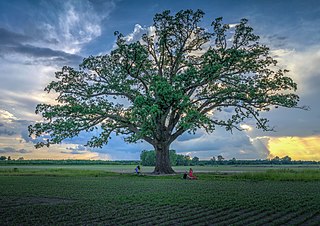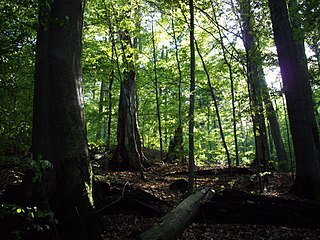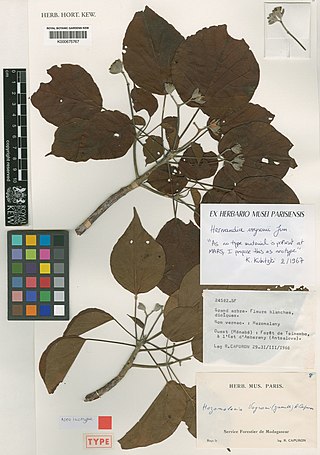
Quercus macrocarpa, the bur oak or burr oak, is a species of oak tree native to eastern North America. It is in the white oak section, Quercus sect. Quercus, and is also called mossycup oak, mossycup white oak, blue oak, or scrub oak. The acorns are the largest of any North American oak, and are important food for wildlife.

Quercus douglasii, known as blue oak, is a species of oak endemic to California, common in the Coast Ranges and the foothills of the Sierra Nevada. It is California's most drought-tolerant deciduous oak, and is a dominant species in the blue oak woodland ecosystem. It is occasionally known as mountain oak and iron oak.

Acer pensylvanicum, known as the striped maple, moosewood, moose maple or goosefoot maple, is a small North American species of maple. The striped maple is a sequential hermaphrodite, meaning that it can change its sex throughout its lifetime.

Adansonia madagascariensis or Madagascar baobab is a small to large deciduous tree in the family Malvaceae. It is one of six species of baobab endemic to Madagascar, where it occurs in the Madagascar dry deciduous forests.

Adansonia rubrostipa, commonly known as fony baobab, is a deciduous tree in the Malvaceae family. Of eight species of baobab currently recognized, six are indigenous to Madagascar, including fony baobab. It is endemic to western Madagascar, found in Baie de Baly National Park, south. It is associated with well-drained soils and is found in dry and spiny forests. It occurs in the following protected areas: Amoron'i Onilahy, Baie de Baly, Menabe Antimena, Mikea, Namoroka, Ranobe PK 32, Tsimanampesotse, Tsimembo Manambolomaty, Tsinjoriake.

Temperate deciduous or temperate broad-leaf forests are a variety of temperate forest 'dominated' by deciduous trees that lose their leaves each winter. They represent one of Earth's major biomes, making up 9.69% of global land area. These forests are found in areas with distinct seasonal variation that cycle through warm, moist summers, cold winters, and moderate fall and spring seasons. They are most commonly found in the Northern Hemisphere, with particularly large regions in eastern North America, East Asia, and a large portion of Europe, though smaller regions of temperate deciduous forests are also located in South America. Examples of trees typically growing in the Northern Hemisphere's deciduous forests include oak, maple, basswood, beech and elm, while in the Southern Hemisphere, trees of the genus Nothofagus dominate this type of forest. Temperate deciduous forests provide several unique ecosystem services, including habitats for diverse wildlife, and they face a set of natural and human-induced disturbances that regularly alter their structure.

Adansonia grandidieri is the biggest and most famous of Madagascar's six species of baobabs. It is sometimes known as Grandidier's baobab or the giant baobab. In French it is called Baobab malgache. The local name is renala or reniala. This tree is endemic to the island of Madagascar, where it is an endangered species threatened by the encroachment of agricultural land. This is the tree found at the Avenue of the Baobabs.

Pericopsis elata is a species of flowering plant in the family Fabaceae and is known by the common names African teak, afromosia, afrormosia, kokrodua and assamela.

Burkea africana, the wild syringa, is a deciduous, medium-sized, spreading, flat-topped tree which grows in the woodlands and savannas of sub-Saharan Africa. It is the sole species in genus Burkea, which belongs to the subfamily Caesalpinioideae of the family Fabaceae.

Syzygium guineense is a leafy forest tree of the family Myrtaceae, found in many parts of Africa both wild and domesticated. Both its fruits and leaves are edible; the pulp and the fruit skin are sucked and the seed discarded. It is sometimes called "waterberry", but this may also refer to other species of Syzygium.
Malacantha alnifolia is species of flowering plant in the family Sapotaceae. It is a tree native to tropical Africa. It is the sole species in genus Malacantha.
Brenierea insignis is a species of flowering plants in the legume family, Fabaceae. It belongs to the subfamily Cercidoideae and is the only member of the genus Brenierea. It is endemic to Madagascar.
Celtis zenkeri is a species of flowering plant native to sub-Saharan Africa.

Schleichera is a monotypic genus of plants in the soapberry family, Sapindaceae. There is only one species, Schleichera oleosa, a tree that occurs in the Indian Subcontinent and Southeast Asia.
Schizozygia is a monotypic genus of plant in the family Apocynaceae found in tropical Africa and the Comoros. As of July 2020, Plants of the World Online recognises the single species Schizozygia coffaeoides.

Quercus castanea is a species of oak tree. It is widespread across much of Mexico, from Sonora to Chiapas, and in Guatemala, El Salvador, and Honduras.
Marcanodendron codesuri is a species of flowering plant belonging to the family Malvaceae. It is a tree native to Bolívar state in Venezuela, where it is commonly known as algodoncillo. It is the sole species in genus Marcanodendron.

Hernandia voyronii, commonly known as Hazomalany, is a species of plant in the Hernandiaceae family. It is endemic to Madagascar.
Croton macrostachyus is a species of flowering plant native to the mountains of Sub-Saharan Africa.
Aningeria pierrei is a species of plant in the family Sapotaceae. It is a tree native to the tropical forests of west and west-central Africa, from Guinea Bissau to the western Central African Republic. It is commonly known as aningré blanc, and is a source of the timber known as anigre.














